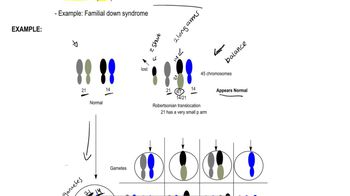What is the most likely mode of inheritance for the trait depicted in the following human pedigree?
Table of contents
- 1. Introduction to Genetics51m
- 2. Mendel's Laws of Inheritance3h 37m
- 3. Extensions to Mendelian Inheritance2h 41m
- 4. Genetic Mapping and Linkage2h 28m
- 5. Genetics of Bacteria and Viruses1h 21m
- 6. Chromosomal Variation1h 48m
- 7. DNA and Chromosome Structure56m
- 8. DNA Replication1h 10m
- 9. Mitosis and Meiosis1h 34m
- 10. Transcription1h 0m
- 11. Translation58m
- 12. Gene Regulation in Prokaryotes1h 19m
- 13. Gene Regulation in Eukaryotes44m
- 14. Genetic Control of Development44m
- 15. Genomes and Genomics1h 50m
- 16. Transposable Elements47m
- 17. Mutation, Repair, and Recombination1h 6m
- 18. Molecular Genetic Tools19m
- 19. Cancer Genetics29m
- 20. Quantitative Genetics1h 26m
- 21. Population Genetics50m
- 22. Evolutionary Genetics29m
2. Mendel's Laws of Inheritance
Pedigrees
Problem 19
Textbook Question
Researchers examined a family with an interesting distribution of Leigh syndrome symptoms. In this disorder, individuals may show a progressive loss of motor function (ataxia, A) with peripheral neuropathy (PN, meaning impairment of the peripheral nerves). A mitochondrial DNA (mtDNA) mutation that reduces ATPase activity was identified in various tissues of affected individuals. The accompanying table summarizes the presence of symptoms in an extended family.
Person Condition Percent Mitochondria with
Mutation
Proband A and PN >90%
Brother A and PN >90%
Brother Asymptomatic 17%
Mother PN 86%
Maternal uncle PN 85%
Maternal cousin A and PN 90%
Maternal cousin A and PN 91%
Maternal Asymptomatic 56%
grandmother
Develop a pedigree that summarizes the information presented in the table.
 Verified step by step guidance
Verified step by step guidance1
Step 1: Understand the inheritance pattern of Leigh syndrome. Leigh syndrome is associated with mitochondrial DNA (mtDNA) mutations, which are inherited maternally. This means that only females pass the mutation to their offspring, regardless of the offspring's sex.
Step 2: Identify the affected individuals and their symptoms from the table. Note that individuals with >90% mutated mtDNA show severe symptoms (A and PN), while those with lower percentages may show milder symptoms (PN) or be asymptomatic.
Step 3: Begin constructing the pedigree. Start with the maternal grandmother at the top, as mtDNA is inherited maternally. Indicate her as asymptomatic with 56% mutated mtDNA. Draw her offspring: the mother and maternal uncle. The mother has PN (86% mutated mtDNA), and the maternal uncle has PN (85% mutated mtDNA).
Step 4: Add the next generation. The mother has three children: the proband (A and PN, >90%), two brothers (one with A and PN, >90%, and one asymptomatic with 17%). The maternal uncle has two children: both maternal cousins with A and PN (90% and 91%).
Step 5: Use standard pedigree symbols to represent individuals and their conditions. Circles represent females, squares represent males, and shading indicates the presence of symptoms. Include percentages of mutated mtDNA next to each individual to provide additional context.
 Verified video answer for a similar problem:
Verified video answer for a similar problem:This video solution was recommended by our tutors as helpful for the problem above
Video duration:
3mPlay a video:
Was this helpful?
Key Concepts
Here are the essential concepts you must grasp in order to answer the question correctly.
Mitochondrial Inheritance
Mitochondrial inheritance refers to the transmission of genetic traits through mitochondrial DNA (mtDNA), which is inherited exclusively from the mother. This type of inheritance is significant in disorders like Leigh syndrome, where mutations in mtDNA can lead to various symptoms, including neurological deficits. Understanding this concept is crucial for analyzing the familial patterns of the disorder presented in the question.
Recommended video:
Guided course

Organelle Inheritance
Leigh Syndrome
Leigh syndrome is a severe neurological disorder characterized by progressive loss of mental and movement abilities, often resulting from mitochondrial dysfunction. Symptoms can include ataxia and peripheral neuropathy, as seen in the affected individuals in the family described. Recognizing the symptoms and their association with mitochondrial mutations is essential for interpreting the family's health history.
Recommended video:
Guided course

Robertsonian Translocations
Pedigree Analysis
Pedigree analysis is a method used to visualize the inheritance patterns of traits within a family over generations. It helps in identifying carriers of genetic conditions and understanding the likelihood of passing on genetic disorders. In this case, constructing a pedigree based on the symptoms and mitochondrial mutation percentages will aid in clarifying the genetic relationships and potential inheritance patterns of Leigh syndrome in the family.
Recommended video:
Guided course

Pedigree Flowchart
Related Videos
Related Practice
Textbook Question
746
views


